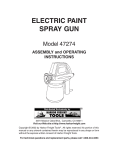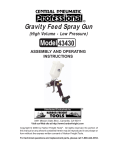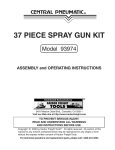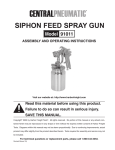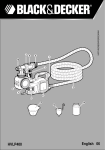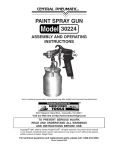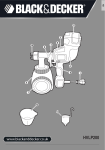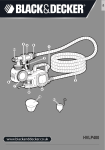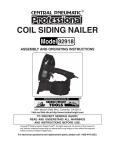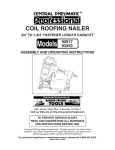Download Chicago Electric CORDLESS SPRAY GUN 90880 Operating instructions
Transcript
CORDLESS SPRAY GUN 18 VOLTS 90880 ASSEMBLY AND OPERATING INSTRUCTIONS 3491 Mission Oaks Blvd., Camarillo, CA 93011 Visit our Web site at http://www.harborfreight.com Copyright © 2003 by Harbor Freight Tools®. All rights reserved. No portion of this manual or any artwork contained herein may be reproduced in any shape or form without the express written consent of Harbor Freight Tools. For technical questions and replacement parts, please call 1-800-444-3353 Specifications Item Power Consumption Canister Capacity Battery Capacity Battery Type Battery Charger Delivery Viscosity Stainless Steel Nozzles Spray Functions Dimensions Weight Accessories Description Battery, 18 VDC, 1.7 Amp Hours 15 oz. (500 ml) 15 to 20 containers per full battery charge 18 VDC, Ni-Cad, 1.7 AH Class II, 120 VAC, 60 Hz; Output: 24 VDC, 200 mA 10 oz. (300 ml) per minute (water) (maximum) 30 DIN-sec (maximum) 2 – Round jet, 0.019” (dia.) 0.5 mm; For lighter body and sealer liquids 1 – Angle Nozzle Adapter, 0.023” (dia.) 0.6 mm; Slightly flexible; For latex, stain, and oil base paint 4 settings, adjustable 10 (H) x 3-1/4 (W) inches; At canister 9-5/8 (L) inches; Side Handle: 4 (L) inches 4.6 lbs. Blow mold case Viscosity cup with hanger Cleaning needle Nozzle Extension Save This Manual You will need the manual for the safety warnings and precautions, assembly instructions, operating and maintenance procedures, parts list and diagram. Keep your invoice with this manual. Write the invoice number on the inside of the front cover. Keep the manual and invoice in a safe and dry place for future reference. General Safety Warnings and Precautions WARNING: When using tool, basic safety precautions should always be followed to reduce the risk of personal injury and damage to equipment. Read all instructions before using this tool! 1. Keep work area clean. Cluttered areas invite injuries. 2. Observe work area conditions. Do not use machines or power tools in damp or wet locations. Don’t expose to rain. Keep work area well lighted. Do not use electrically powered tools in the presence of flammable gases or liquids. 3. Keep children away. Children must never be allowed in the work area. Do not let them handle machines, tools, or extension cords. 4. Store idle equipment. When not in use, tools must be stored in a dry location to inhibit rust. Always lock up tools and keep out of reach of children. 5. Use the right tool for the job. Do not attempt to force a small tool or attachment to do the work of a larger industrial tool. There are certain applications for which this tool was designed. It will do the job better and more safely at the rate for which it was intended. Do not modify this tool and do not use this tool for a purpose for which it was not intended. 6. Dress properly. Do not wear loose clothing or jewelry as they can be caught in moving parts. Protective, electrically non-conductive clothes and non-skid footwear are recommended when working. Wear restrictive hair covering to contain long hair. SKU 90880 Page 2 7. Use eye, nose and mouth protection. Always wear ANSI approved impact safety goggles. Wear an ANSI approved dust mask or respirator when working chemical and paint dusts and mists. 8. Do not overreach. Keep proper footing and balance at all times. Do not reach over or across running machines. 9. Maintain tools with care. Keep tools clean for better and safer performance. Follow instructions for lubricating and changing accessories. Inspect tool cords periodically and, if damaged, have them repaired by an authorized technician. The handles must be kept clean, dry, and free from oil and grease at all times. 10. Disconnect power. Unplug Battery Charger when not in use. 11. Avoid unintentional starting. Be sure the switch is in the Off position when not in use and before plugging Battery in. Do not carry any tool with your finger on the trigger. 12. Stay alert. Watch what you are doing, use common sense. Do not operate any tool when you are tired. 13. Check for damaged parts. Before using any tool, any part that appears damaged should be carefully checked to determine that it will operate properly and perform its intended function. Check for alignment and binding of moving parts; any broken parts or mounting fixtures; and any other condition that may affect proper operation. Any part that is damaged should be properly repaired or replaced by a qualified technician. Do not use the tool if any switch does not turn On and Off properly. 14. Replacement parts and accessories. When servicing, use only identical replacement parts. Use of any other parts will void the warranty. Only use accessories intended for use with this tool. Approved accessories are available from Harbor Freight Tools. 15. Do not operate tool if under the influence of alcohol or drugs. Read warning labels if taking prescription medicine to determine if your judgment or reflexes are impaired while taking drugs. If there is any doubt, do not operate the tool. 16. Maintenance. For your safety, service and maintenance should be performed regularly by a qualified technician. 17. Pacemaker safety warning. People with pacemakers should consult with their physician(s) before using this product; operation of equipment in close proximity to a heart pacemaker could cause interference or failure of the pacemaker. 18. Use tools with both hands when required. Many tools such as chain saws, drills, routers, etc., require the use of both hands when operating. This helps maintain tool stability and keeps hands away from the working area of the tool. Note: Performance of this tool may vary depending on variations in battery power. Warning: The warnings, cautions, and instructions discussed in this instruction manual cannot cover all possible conditions and situations that may occur. It must be understood by the operator that common sense and caution are factors which cannot be built into this product, but must be supplied by the operator. SKU 90880 Page 3 Battery Precautions 1. Read all instructions and warnings on the battery before charging the battery. 2. To avoid accidents, charge the supplied battery only. Do not use a different charger with this battery. 3. Do not expose the battery to rain or wet conditions. 4. To avoid damage of cable and plug, never pull the cable to disconnect the charger. 5. Do not use the charger if the cable or plug are damaged. 6. Repairs should be carried out by a qualified technician. 7. Do not touch the battery poles with any conductive source. 8. Do not store the battery in a box with other metal objects; store the battery in the carrying case. 9. Do not throw the battery in a fire or in the general trash. Contact your local hazardous waste disposal authority for proper disposal. 10. Do not drain the battery completely before recharging. Recharge fully. Always use a fresh battery when tool performance begins to diminish. Severe heat is most destructive to a battery; the more heat generated, the faster the battery loses power. A battery that gets too hot can be permanently damaged. Never over-discharge a battery by using the tool even after tool performance is decreasing. Never attempt to discharge a tool’s battery by continuing to pull the tool trigger. When tool performance begins to diminish, stop the tool, recharge the battery and use the fresh battery for optimal performance. 11. Recharge the battery monthly even if not used. 12. Always remove the battery from the Spray Gun before performing inspection, maintenance, cleaning procedures, or storage. Specific Safety Rules for the Spray Gun 1. Never point the Spray Gun towards people or animals. 2. The Spray Gun must be used only for paints and solvents with a 21 degree C minimum flashpoint. 3. The high pressure spray can potentially cause severe skin damage, Never allow any part of the body to come in contact with the spray. 4. In case of skin injection by the high pressure spray, contact a physician immediately. The physician should be told the type of sprayed material involved. 5. Do not smoke or eat in the area where the Spray Gun is used. 6. Provide sufficient ventilation to keep the air in the spraying area free from the accumulation of flammable vapors. 7. Do not spray any material of unknown composition. SKU 90880 Page 4 8. Do not operate the Spray Gun without the nozzle Locknut (3) in place. 9. Never use gasoline or other flammable liquids to clean the Spray Gun. Fire or explosion could occur. Damage to Spray Gun components could occur. 10. Always read the paint manufacturer’s thinning recommendations or instructions before using paint or other materials. 11. Always carefully cover areas that are not to be painted to prevent property damage. 12. Stop using the Spray Gun if it becomes overly hot; allow the tool to cool down before using it again. WARNING: This product contains lead, which is a chemical known to the State of California to cause cancer and birth defects or other reproductive harm. (California Health & Safety Code 25249.5, et seq.) Unpacking When unpacking, check to make sure the following parts are included. If any parts are missing or broken, please call Harbor Freight Tools at the number on the cover of this manual as soon as possible. Side Handle (28) Nozzle Extension Valve (2) Viscosity Cup (30) Blow Mold Case (33) Battery (26) Charger Base (31) Spray Gun AC Adapter (32) SKU 90880 Page 5 Operation CHARGING BATTERY The Battery (26) does not come charged from the factory. Charge the Battery before using. Battery (26) AC Adapter (32) Charger Base (31) 1. Insert the Battery (26) into the Charger Base (31). The Battery can only insert one way. 2. Insert the AC Adapter (32) cord plug into the Charger Base as shown above. 3. Plug the AC Adapter module into an electrical outlet. The Charging Indicator turns green, indicating charging. The Battery will charge for approximately 5 hours on the first charge. Subsequent charges should only take about one hour. When the Battery is completely charged, the Charger will automatically shut off, and the Indicator turns red. 4. Remove the Battery when it is fully charged. 5. Unplug the AC Adapter from the electrical outlet. Note: The operation time of a new battery will ramp up as it is properly used (drained) and recharged. It will take about 5 recharging cycles before the Battery is at maximum efficiency. Caution: If two or more batteries are to be charged, avoid damaging the Charger by allowing it to cool down between charges. Wait for the Battery to cool down before placing in the Spray Gun. INSERTING BATTERY Caution: Before inserting the Battery Pack into the tool, be certain that the Trigger Switch (20) is in the Off position. 1. Push the Operational Lock (21) to the Off position. 2. Insert Battery into the receptacle at the handle-bottom of the Spray Gun. 3. Secure the Lock-spring Clasps to each side of the handle. PREPARATION OF SURFACE TO BE SPRAYED SKU 90880 Page 6 REV 10/04 The surface to be sprayed should be free of dust, dirt, and grease. In some instances, a primer coat should be applied before spraying the final coat. PREPARATION OF PAINT TO BE SPRAYED Most paints and stains are supplied ready for brush applications. They may need to be thinned before using in the Spray Gun. Refer to the paint manufacturer’s recommendations for thinning their product. Test the viscosity of the product before thinning. 1. Purchase fresh paint and have it mixed thoroughly by machine. When using lacquer, stir to mix the liquid. When shaken, air bubbles are produced which may give an uneven spray. If the paint or other fluid is old, it may be necessary to strain the fluid of all debris and lumps before spraying. 2. Check the viscosity of the paint using the Viscosity Cup (30). After mixing the paint, fill the Viscosity Cup (30) up to the brim with paint. Do this over the paint container. Measure the time it takes for the cup to empty. The time should be between 15 and 30 seconds for proper operation in the Spray Gun. The table below gives the recommended (viscosity) times for various types of paints and stains. Spraying Materials Plastic and latex paint Water based paints Primers Varnishes Oil based paints Enamel paints Aluminum paints Car under-seal Wood sealers Wood preservatives Wood stains Recommend Viscosity Time (in Seconds) 24 ~ 28 20 ~ 25 24 ~ 28 20 ~ 25 18 ~ 22 18 ~ 22 22 ~ 25 25 ~ 35 28 ~ 35 No thinning required No thinning required (30) If the paint takes longer than the recommended time to empty from the Viscosity Cup, then further thinning is necessary. Mix in a small quantity of the appropriate thinner and test the viscosity again until the correct viscosity is achieved. If particles or lumps are present, strain the paint using a disposable strainer (not supplied) until clean. FILLING THE CANISTER 1. Push the Switch Lock (21) to the Off position. 2. Unscrew the Canister (25) from the Canister Lid (11). 3. Carefully pull off the Suction Tube (23). 4. Turn the Spray Gun upside down and apply a few drops of light oil into the two holes (X and Y) under the Lid (11). This helps keep the Spray Gun parts lubricated and minimizes clogging. Refer to the photo at the top of page 8. SKU 90880 Page 7 Lock Nut (3) (X) (Y) Switch Lock (21) Trigger Switch (20) Nozzle (1) Canister Lid (11) Suction Tube (23) 5. Push the Suction Tube (23) back into the Canister Lid. 6. Fill the Canister (25) with paint of the correct viscosity, then carefully screw the Canister back into the Canister Lid. Securely tighten. The easiest way to do this without spilling paint is to leave the full Canister on a flat surface. Lift the Spray Gun and carefully place the Suction Tube into the Canister. When the top of the Canister reaches the Canister Lid, begin turning the Canister until it screws into the Canister Lid. Securely tighten. BEGIN SPRAYING Note: Always carefully cover areas and objects that are not to be painted to prevent property damage. 1. Verify that Lock Nut (3) and Nozzle (1) are tightened securely. See photo above. 2. Push the Switch Lock (21) to the On position. This activates the Trigger Switch (20). 3. Hold the Spray Gun horizontally and press the Trigger Switch (20). The Spray Gun should begin spraying. It is recommended to spray for two minutes, then leave off for three minutes. This prevents overheating and lengthens Battery use. 4. Adjust the Spray output by pressing the spray adjust Button (15) while spraying. Press once for each level of spray. Above the Button (15) are four Spray Control Regulator (14) LED lights. Each LED represents a different level of spray volume. When lit, the left LED indicates the maximum spray output. The right LED indicates the minimum spray output. 5. When Spraying is complete, release the Trigger Switch (20) and press the Switch Lock (21) to the Off position. (14) (15) SKU 90880 Left LED Lit Page 8 Right LED Lit MOUNTING THE SIDE HANDLE For ease of use and more spraying control, it may be desirable to mount the Side Handle (28) to the Housing (27). It can be mounted to either the left or right side of the Housing (27). 1. To mount the Side Handle (28), remove the rubber cap covering the threaded connector (on either side of the housing). 2. Screw the Side Handle into the housing until securely tightened. SPRAYING TECHNIQUES The following are some general tips while spray painting. Also refer to the illustrations below. • Keep the Spray Gun level and perpendicular to the surface being painted. • Keep the Nozzle 10 to 12 inches from the spraying surface. • Spray evenly: side-to-side, up and down, with smooth and even strokes at one speed. • Spraying at an angle will cause drips. • Move the Spray Gun using a sweeping arm motion, rather than wrist motion. • Never start or stop spraying while aimed at the surface being painted. • Spraying strokes at a fast speed will produce a light coat. Strokes at a slow speed will produce a heavier coat. • Spray only one coat at a time. Allow paint to properly dry before applying another coat. • Do not tip the Spray Gun more than 45 degrees while spraying. SKU 90880 Page 9 CHANGING THE NOZZLE 1. Push the Switch Lock (21) to the Off position, and remove the battery. 2. Unscrew the Nozzle (1) by turning it counterclockwise. (3) (2) (1) Make sure that the Valve (2) remains in the Cylinder (4). 3. Insert the new Nozzle (1) into the Cylinder (4) and securely tighten it clockwise. MOUNTING THE NOZZLE EXTENSION The Nozzle Extension accessory can be used to paint in areas of limited access. It should be used to paint ceilings and floors. Unscrew 1. 2. Push the Switch Lock (21) to the Off position, and remove the battery. (1) (2) (1) Unscrew the Nozzle (1) by turning it counterclockwise. Remove it from the Cylinder (4). Make sure the Valve (2) remains in the Cylinder. (4) (2) Nozzle Extension Screw In 3. Screw the Nozzle Extension securely onto the Cylinder (4). 4. Carefully bend the Nozzle Extension into the required position (up or down) for spraying. The Spray Gun should be kept level (horizontal) during spraying. CHANGING THE PISTON ASSEMBLY (3) 1. Push the Switch Lock (21) to the Off position, and remove the battery. (2) (1) 2. Loosen the Nozzle (1) slightly by turning it counterclockwise, and unscrew the Lock Nut (3). 3. Pull the Nozzle (1) and Piston Assembly (3, 4, 6, and 7) out of the unit. 3. Unscrew the Nozzle (1) and slide the Lock Nut (3) from the Piston (7) assembly. Store or clean Piston (7). 4. Remove the Nozzle (1) from the new Piston (7) assembly and slide the Piston Spring (6) and Cylinder (4) onto the new Piston (7). 5. Slide the whole Piston (7) assembly into the unit and secure by screwing the Lock Nut (3) clockwise onto the unit. 6. Screw on the Nozzle (1) until secure. SKU 90880 Page 10 (7) (6) (4) Maintenance Caution: Before performing any repair or maintenance procedure, remove the Battery from the Spray Gun Handle. Never immerse the Spray Gun in water to clean. Clean the Spray Gun components immediately after each use as described below. 1. Unscrew the Canister (25) and pour the remaining paint back into the paint can. 2. Thoroughly clean the Canister with the appropriate thinner/cleaner (water or paint thinner). 3. Pour some appropriate thinner (water or paint thinner) into the Canister, and operate the Spray Gun until only clean thinner comes out of the Nozzle. 4. Unscrew the Canister and remove the Suction Tube (23) and Filter (24). Thoroughly clean with the appropriate thinner. See illustration at bottom-left. 5. Loosen the Nozzle (1) slightly, unscrew the Lock Nut (3), then pull the Nozzle and Piston (7) assembly out of the unit. See illustration at bottom-left. 6. Remove the Nozzle (1) and Lock Nut (3) from the Cylinder (4). Remove Valve (2) from the Cylinder (4). Thoroughly clean these components. See illustration bottom-center. 7. Use the Cleaning Pin accessory to clear the Nozzle (1) and the swirl head of Valve (2). 8. Apply a few drops of light lubricating oil to the Piston (7), Piston Spring (6), and Cylinder (4). See illustration at bottom-right. 9. Reassembly the Nozzle (1) and Piston (7) assembly as described on the previous page. 10. Reassembly the Suction Tube (23), Filter (24), and Canister (25). 11. Clean the outside of the Spray Gun with a clean, moist cloth. 12. Recharge the batteries as previously described on page 6. 13. Store Spray Gun and accessories in the Blow Mold Case, and place in a clean and dry location. SKU 90880 Page 11 Troubleshooting Symptom Motor hums but no spraying occurs; Or, irregular spraying 1. 2. 3. 4. 5. 6. 1. Spray atomization is not good Over painting and dripping Motor is louder than normal Operating sound not normal Orange peel effect when spraying; Excessive fogging Spray Gun operates only for a short time 2. Probable Cause Worn Valve Piston Stuck Suction Tube not in place Blocked Suction Tube and/or Filter Blocked Nozzle Loosened Lock Nut Nozzle or Lock Nut is not tightened Paint is too thick 1. Spray Gun too close to the object being sprayed 2. Too much paint being sprayed 3. Viscosity is too low Spray Gun components are not clean or lubricated 1. Poor output adjustment 2. Not enough paint in the Canister 3. Not diluted properly or not passing through the Suction Tube 4. Battery charge is low 1. Incorrect thinner being used 2. Spray Gun too far from the surface 3. Paint is too thick 1. Battery is not fully charged 2. Charger is defective 3. Battery life is expired SKU 90880 Page 12 Possible Solution Replace Valve Clean Piston with thinner Adjust Suction Tube Clean Suction Tube and Filter with thinner 5. Clean Nozzle with thinner 6. Tighten Lock Nut 1. Tighten the Nozzle and Lock Nut 2. Check the viscosity of the paint 1. Keep Spray Gun 10” to 12” from the surface 2. Adjust the Spray Control Regulator to reduce spraying volume 3. Check paint viscosity Disassemble and clean Spray Gun components, and lubricate 1. Adjust the Spray Control Regulator to reduce spraying volume 2. Refill Canister with paint 3. Check Suction Tube and viscosity 1. 2. 3. 4. 4. Recharge battery 1. Completely clean Spray Gun components and start again with the correct thinner 2. Hold Spray Gun closer to surface 3. Paint is too thin 1. Fully charge the Battery 2. Replace Charger Base and/or AC Adapter 3. Replace Battery with same type Parts List Item 1. 2. 3. 4. 5. 6. 7. 8. 9. 10. 11. 12. 13. 14. 15. 16. 17. 18. 19. 20. 21. 22. 23. 24. 25. 26. 27. 28. 29. 30. 31. 32. 33. 34. 35. Description Nozzle Valve Lock Nut Cylinder Airtight Ring Piston Spring Piston Drive Housing Armature Sleeve Canister Lid Coil Electronic Control Regulator, Spray Control Button Cover, Regulator Connector, Battery Switch, Safety Spring Switch, Trigger Lock, Switch Absorber Tube, Suction Filter Canister Battery Pack, 18V, Ni-Cad, 1.7 AH Housing x 2 Side Handle Screw, 4.2x16 Viscosity Cup Charger Base AC Adapter Blow Mold Case Cleaning Pin Accessory Nozzle Extension NOTE: Some parts are listed and shown for illustration purposes only and are not available individually as replacement parts. PLEASE READ THE FOLLOWING CAREFULLY THE MANUFACTURER AND/OR DISTRIBUTOR HAS PROVIDED THE PARTS DIAGRAM IN THIS MANUAL AS A REFERENCE TOOL ONLY. NEITHER THE MANUFACTURER NOR DISTRIBUTOR MAKES ANY REPRESENTATION OR WARRANTY OF ANY KIND TO THE BUYER THAT HE OR SHE IS QUALIFIED TO MAKE ANY REPAIRS TO THE PRODUCT OR THAT HE OR SHE IS QUALIFIED TO REPLACE ANY PARTS OF THE PRODUCT. IN FACT, THE MANUFACTURER AND/OR DISTRIBUTOR EXPRESSLY STATES THAT ALL REPAIRS AND PARTS REPLACEMENTS SHOULD BE UNDERTAKEN BY CERTIFIED AND LICENSED TECHNICIANS AND NOT BY THE BUYER. THE BUYER ASSUMES ALL RISK AND LIABILITY ARISING OUT OF HIS OR HER REPAIRS TO THE ORIGINAL PRODUCT OR REPLACEMENT PARTS THERETO, OR ARISING OUT OF HIS OR HER INSTALLATION OF REPLACEMENT PARTS THERETO. SKU 90880 Page 13 Assembly Drawing SKU 90880 Page 14














